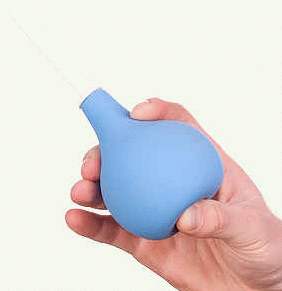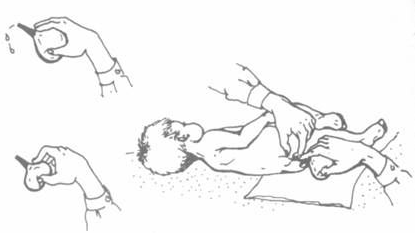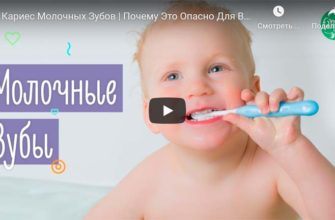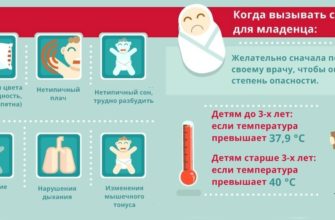While a newborn or infant is being breastfed, there is little need to worry about intestinal function. If the baby is calm, gains weight well, then with breastfeeding bowel movement can be from 1 to 10 times a day (See how many times a newborn poo) But if a child cannot go to the toilet for a long time, then you need to take some measures, and all mothers should know how to properly make an enema for a newborn child so as not to harm the baby.

Enema is a medical procedure that involves the introduction of fluid (water or a drug) into the rectum.
Why and in which cases do an enema

With the beginning of adding adapted infant formula to the baby’s nutrition, you need to follow the work of the intestines for some time. And although the mixtures are already as close as possible to breast milk, the baby's body must still adapt them for itself. In the event of one-time constipation (if the child for example, do not poop), parents should be able to make an enema for a small newborn child without fear and problems. BUT, if constipation occurs constantly, you need to consult a specialist, in this case, do not self-medicate.
Enema is made into a newborn by a pear (syringe), it is sold in a pharmacy. Choose a small, under the volume of fluid needed by the baby by age. Only syringes with a soft rubber tip are used for newborns.
At home, enemas are done for infants to:
- the introduction of drugs;
- bowel cleansing for constipation;
- with food poisoning.
The purpose of these procedures: in the first case - to accelerate the effect of the drug by rapid administration, in the second - to increase intestinal motility to remove feces by mechanical irritation of the intestinal mucosa with liquid.
You might be interested in: How to give a baby medicine in the form of a tablet or syrup - instructions for parents
Types of enemas
Enema can be 5 types:
- Cleansing. It is indicated for constipation, bloating, food poisoning, for bowel movement from stool and gas. Make ordinary boiled water at room temperature (22-24 degrees). From cold water there will be intestinal cramps. Too warm water is absorbed into the intestine along with the toxic substances in it. So you can provoke poisoning of the body ("fecal intoxication"), the symptoms of which are fever, vomiting. The most terrible condition that can develop with this complication is cerebral edema.
- Medicinal This is a method of administering a drug substance. It is carried out as prescribed by the doctor. You need to do it after a cleansing enema.
- Oily. This enema is indicated for constipation, especially when the baby has a dense consistency of feces. Do with constipation in a newborn Vaseline, hemp or sunflower oil, heated to 37 degrees (You can dilute them with a small amount of saline). The oil envelops the intestinal wall and has a mild laxative effect.
- Hypertonic. A pear for an enema is filled with a hypertonic solution (2.5%, 5% or 10%) of sodium chloride. This type of enema cleanses the intestines very well with prolonged constipation and is most often performed in a hospital setting by medical professionals. Salt solution well draws on the contents of the intestine.
- Siphon. It is done only in cases of severe poisoning. It is performed in a medical facility under the supervision of medical staff.
It should be remembered that an enema is a last resort. Often, experts categorically do not recommend doing it, since the intestinal flora, which is just beginning to form, is washed out in this way. In addition, a regular enema can disrupt intestinal motility, after which the newborn simply will not be able to empty itself.
At home, newborns are recommended to do cleansing and oil enemas. For the procedure, an adult should have at hand: boiled and cooled to the desired temperature water (oil), pear (douche) with a soft tip, petroleum jelly (can be replaced with baby cream), oilcloth.
Therapeutic solutions
To perform a cleansing enema, conventional boiled water is traditionally recommended. However, for certain indications, for example, spastic constipation (its symptoms are “sheep” feces and intestinal colic), you can replace the water with vegetable oil from sunflower or hemp.
Oil enemas do not have age-related contraindications, but special care should be taken during the procedure so as not to overheat the oil and burn the child. Its optimum temperature should not exceed 37 °, and the cleaning effect occurs after 7-8 hours, so such an enema is best done at night.
Glycerin also contributes to stool softening. To prepare a glycerin solution, you need to add 2 tsp. oily liquid (purchased at the pharmacy) in a glass of water. The same ratio (2 teaspoons per 250 ml) is used to prepare chamomile broth.
With atonic constipation, manifested in the form of constant stool delays, it is possible to prepare a saline solution (½ teaspoon of table salt per glass of water). A pronounced effect occurs approximately half an hour after the enema, and all this time the child needs to lie down, refraining from defecation.
How to put an enema to an infant
Before putting an enema, check how much fluid can be injected into the intestines of a newborn baby, depending on its age.
- 1 month baby - enter no more than 25 ml of liquid;
- Up to 6 months - 30-60 ml;
- From 6 to 1 year - 120-130 ml;
- From a year to two - 200 ml;
Also, the volume of fluid can be calculated by the formula: the mass of the child in kg times 10. That is 10 ml per 1 kg. For example, the mass of the child is 5.5 kg, we multiply by 10 we get 55 ml


Step-by-step instructions for setting a cleansing enema
- Wash hands thoroughly with soap and water.
- Boil the pear well. Before starting an enema MANDATORY check for residual hot water inside by squeezing a rubber bulb to prevent burns of the rectal mucosa.
- Place the baby on its back and raise its legs up. (Children over one year old can be put on their left side, pressing their knees to their stomach).
- Squeeze the pear in order to release air, then slowly unclench and pickrequired amount warm boiled water (or saline, oil) at room temperature (not higher than 22-24 ° C).
- Remove excess air from the pear (squeeze the pear until fluid appears).
- Lubricate the tip of the rubber bulb with petroleum jelly (vegetable oil or baby cream) and the anal passage of the baby and, carefully, effortlessly, insert the baby into the anus on 3-5 cm.
- Begin to slowly administer the solution. When emptying the pear without uncleaning (!), Carefully remove it.
- Squeeze the baby’s buttocks and hold them in such a way that the water does not flow out immediately.
- After a few minutes, the baby will definitely have a urge to defecate.
The composition of the enema solution for the newborn
To cleanse the intestines, doctors recommend using the following enemas:
- table salt (1/2 teaspoon of salt per 200 ml of water);
- chamomile infusion (1 tbsp.spoon pour 200 ml of boiling water);
- baby soap (a small piece of soap in a glass);
- baking soda (1 teaspoon of baking soda per glass);
- olive oil (1 teaspoon of oil per 500 ml of water).
How not to do an enema
- unwashed hands;
- administer the solution too quickly;
- use cold or hot water;
- air cannot enter the intestines;
- inject the solution more than the prescribed age norm.
If you put the enema wrong or too often, this can lead to unpleasant consequences:
- the development of inflammatory processes;
- leaching of beneficial intestinal microflora;
- violation of the natural reflex to bowel movement;
- the formation of anal fissures.
Attention! An alternative to a cleansing enema is an enema MICROLAX
Infant give an enema very carefully! Often, enemas are not recommended! Frequent use of cleansing enemas can lead to addiction and a violation of the natural bowel movement. It is better to consult a doctor to determine the causes of the disease and solve the problem.
And a few more tips on the topic:
- Microclyster Microlax (a good remedy for constipation);
- What to do with constipation in a baby;
- List of medicines for constipation;
- Vent pipe (instructions for use).
Instructions video: We put the baby an enema
Shilova Natalia puts an enema, a doctor of the neonatologist of KMN









Instead of petroleum jelly, I lubricate the tip with vegetable oil - this is much more convenient. For an enema, I use herbal decoction (chamomile) in a volume of 75 ml. I think that 150 ml is too much for a baby even 3-5 months old.
It requires dexterity and caution, yet the water needs to be made a little warm, the fact is that warm water is absorbed by the intestines, and this is not always necessary and try to bring the child to a relaxed state before the procedure
This is done so that the water does not spill ahead of time, otherwise there will be no use from the procedure. Well, now we are waiting for the result. After the enema is delivered to the infant and the stool is out, the baby is thoroughly washed.
Do not misinform young mothers, it is FORBIDDEN to do an enema for children with water, since intestinal absorption is very large and this can lead to cerebral edema! Enemas are made with hypertonic or physiological saline!